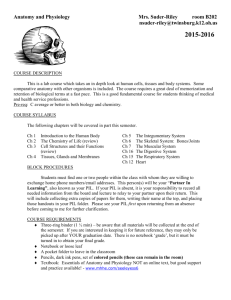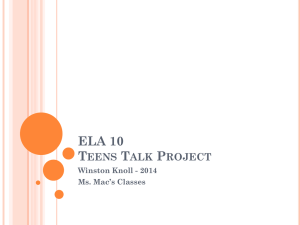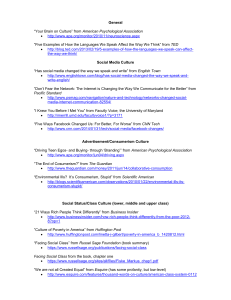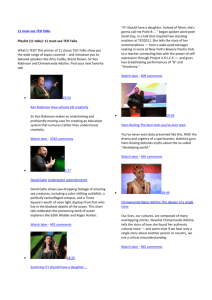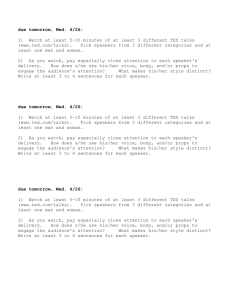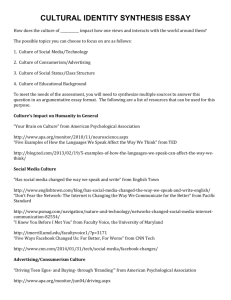T&T Course Outline Jan 2010 - teacherandtech
advertisement
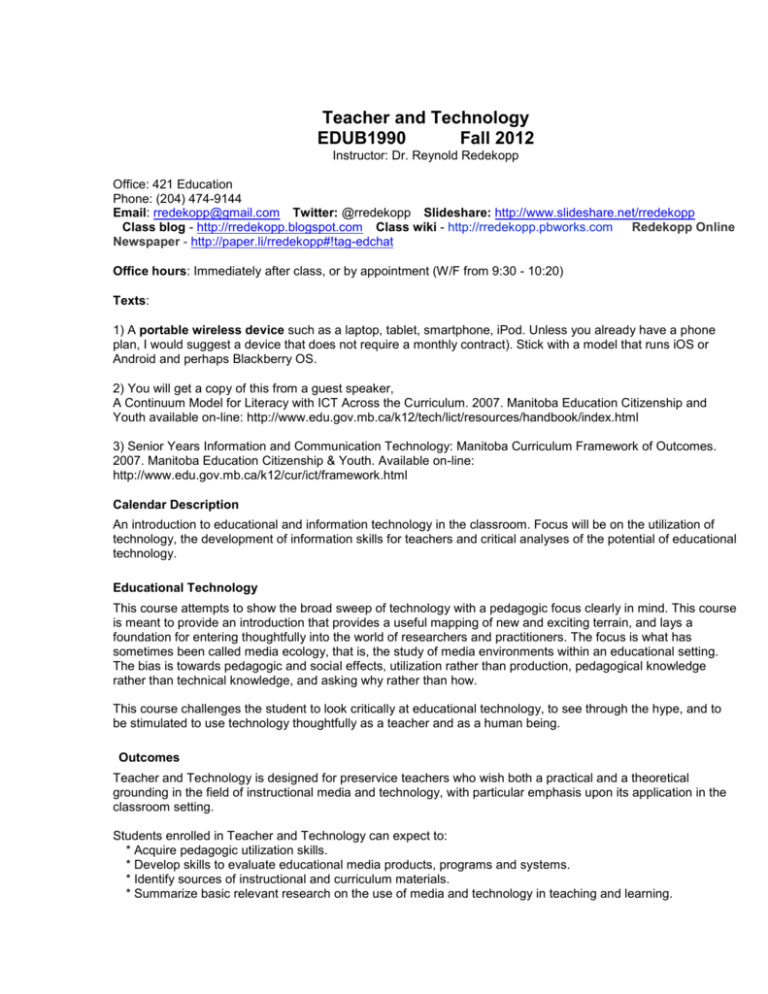
Teacher and Technology EDUB1990 Fall 2012 Instructor: Dr. Reynold Redekopp Office: 421 Education Phone: (204) 474-9144 Email: rredekopp@gmail.com Twitter: @rredekopp Slideshare: http://www.slideshare.net/rredekopp Class blog - http://rredekopp.blogspot.com Class wiki - http://rredekopp.pbworks.com Redekopp Online Newspaper - http://paper.li/rredekopp#!tag-edchat Office hours: Immediately after class, or by appointment (W/F from 9:30 - 10:20) Texts: 1) A portable wireless device such as a laptop, tablet, smartphone, iPod. Unless you already have a phone plan, I would suggest a device that does not require a monthly contract). Stick with a model that runs iOS or Android and perhaps Blackberry OS. 2) You will get a copy of this from a guest speaker, A Continuum Model for Literacy with ICT Across the Curriculum. 2007. Manitoba Education Citizenship and Youth available on-line: http://www.edu.gov.mb.ca/k12/tech/lict/resources/handbook/index.html 3) Senior Years Information and Communication Technology: Manitoba Curriculum Framework of Outcomes. 2007. Manitoba Education Citizenship & Youth. Available on-line: http://www.edu.gov.mb.ca/k12/cur/ict/framework.html Calendar Description An introduction to educational and information technology in the classroom. Focus will be on the utilization of technology, the development of information skills for teachers and critical analyses of the potential of educational technology. Educational Technology This course attempts to show the broad sweep of technology with a pedagogic focus clearly in mind. This course is meant to provide an introduction that provides a useful mapping of new and exciting terrain, and lays a foundation for entering thoughtfully into the world of researchers and practitioners. The focus is what has sometimes been called media ecology, that is, the study of media environments within an educational setting. The bias is towards pedagogic and social effects, utilization rather than production, pedagogical knowledge rather than technical knowledge, and asking why rather than how. This course challenges the student to look critically at educational technology, to see through the hype, and to be stimulated to use technology thoughtfully as a teacher and as a human being. Outcomes Teacher and Technology is designed for preservice teachers who wish both a practical and a theoretical grounding in the field of instructional media and technology, with particular emphasis upon its application in the classroom setting. Students enrolled in Teacher and Technology can expect to: * Acquire pedagogic utilization skills. * Develop skills to evaluate educational media products, programs and systems. * Identify sources of instructional and curriculum materials. * Summarize basic relevant research on the use of media and technology in teaching and learning. * Assess the value of technologies as instructional supports. * Use technologies to address instructional needs. * Summarize new directions and identify emerging technologies in education. * Explore the dark side of technology in education including issues of cheating, plagiarism, privacy, child pornography, cyberbullying and copyright. Email Conventions Instructions for email contact: Due to the large amount of email received, please begin the subject line with EDUB 1990 followed by your section. (eg. EDUB 1990 A13). All attachments should be labeled with EDUB 1990 and your name. Grading A+ 4.50 A 4.00 B+ 3.50 B 3.00 C+ 2.50 C 2.00 D 1.00 0.00 F Note that a B+ is VERY GOOD! Exceptional Excellent Very Good Good Satisfactory Adequate Marginal Failure 95-100 90-94 85-89 80-84 75-79 70-74 60-69 Below 60 Main Theme for 2012 Social Media Kids - these are many of our current students, and there will be more of them as you enter your career. There are claims that this generation is different than any that has come before - that their brains have actually developed differently, and certainly that their learning habits are different. The claims also state that their education needs to be different if there are to achieve their full potential and if our country is to compete and grow. The education system must change, and you as teachers must change - dramatically! That's the 'news' version. What we want to do is explore these ideas as they pertain to recent research about the brain, learning and teaching, and look at how our teaching practices can improve to better serve the kinds of students you will meet in your classrooms. We will also have to explore the impact of the "digital divide." Even if we eventually agree that there is a social media kid, we will have to recognize that there are many children out there who have not had unlimited access to technology all their lives, and who do not have much technology access in their schools either. What do we do about this fairly large group? Attendance at Class Regular attendance is expected of all students in all courses. An instructor can initiate procedures to debar a student from attending classes and from final examinations where unexcused absences exceed three hours of scheduled classes in any one term. Assignments Assignment One (15%) Video and Audio Recording (Posted Online) Due: Sept 28. Create a 1 – 2 minute video and a 1 - 2 minute podcast related to the topic you have chosen for your Web Content (see Assignment 2). It could be an introduction to the topic, a summary and critique of something you have read/watched/listened to, or something else about which you are knowledgable). Both the audio and video must be uploaded to (and displayed on) your web site or be uploaded to another service provider and linked on your web site. Consider: Background (or background noice/echo), practicing to minimize hesitation words (um, ah, like, you know, ...), background/intro/exit music, intro to 'sections' if you are including more than one main idea. Formats: There are many formats out there, but most will not be easily viewed/heard by others from your web site. Make sure that the program you use to record can export to a common format. Mp3 is best for audio and mp4 or mov are best for video. Video: Tutorial link - scroll down to the video tutorial and read online or download Suggested siftware – iMovie (Mac only) or software that came with your webcam or Debut or check out this review or this review. Export as .mp4 or .mov as these can be viewed by almost anyone. Uploading to YouTube is an option, but lots of districts block this. TeacherTube is another option. Audio: Tutorial Links - choose one, but read be careful that you have all that is needed. Suggested siftware – Garageband (free with a Mac) or Audacity – PC and Mac – free). Export as mp3 or publish in a podcast site and link to it. Assignment Two (10%). Meta-Teachnition Three times over the course of the term you will be asked to consider a topic we have discussed in class and think of it in terms of meta-teachnition (a personal position that looks at the issue from a broader perspective). These will be short (250 – 500 words) that you will post in Desire2Learn for this course. Topics may include: digital games in education, 'from facts to thinking', the 'narrow internet', Smartboards in the classroom', BYOD and using them effectively, and others. Details will be given as we approach these topics. These are not research pieces, although you may refer to the class readings and discussions. Assignment Three (30%). Web content Due: Oct 19 ‘Social Media Kids and technology integration in the classroom’ This assignment allows students to explore an issue relating to Digital Natives and technology in the classroom. You are expected to develop an information/teaching site which includes research on one aspect of Digital Natives, resources for a lesson in your curricular area that deals with your topic, and a works cited list of at least five resources (only one of which may be from wikipedia). You will likely have sections on: how are these students different? why is this important for teachers? how technology can be used to create an effective learning experience an overview of a sample lesson or unit that would include relevant ICT references/sources (also put the links directly in/on the text) a personal opinion comment or perspective on this issue. You must utilize technology/ies in order to communicate these ideas. The choice of technology is the decision of the student. It can range from posting the work on a blog site, podcast, wiki site, web page, or other ways of using technology to address ideas. Some topic examples that relate to the use of technology in the classroom in order to support pedagogy are as follows (A maximum of four projects per topic per class, so choose early): Censorship Limitations of the web for Fostering research students’ voices Privacy Identity Digital Games in Educatio Obsolescence and change Web access/informationCreativity as a Ethics Hate sites Fake sites (legitimate or cultural hegemony or melting pot hoax?) reducing diversity? Social media and the influence Developing on critical abilities Attitudes to toward Piracy Cyber-bullying Deconstructing web sites children research the web authorship/ownership of intellectual (relate topic to a certain k property issue) Writing is to generally be in the third person (except the personal comment), and should be written for a generic education audience who might encounter your work without any knowledge of this course. The challenge of the assignment is to be able to move from the mundane and simplistic towards a critical analysis of modes of thinking enhanced by technology and the utilization of contemporary resources. If you meet the basic criteria you will get a B level score. If you desire a higher mark, you must show some insight or present in some unique or ‘outstanding’ way. The criteria for higher marks are ‘excellent’ and ‘exceptional’. We will create an appropriate rubric in class together for this assignment. Total 35 Assignment Four (25%). Group Presentation using the Smartboard. Date Due by sign-up on the class wiki no later than Jan 21: Description: Teachers teach. The challenge here is to teach something to someone using technology. Specifically, class members will be asked to produce and deliver a ten- fifteen minute presentation for class. This will be a small group assignment of 2-3 members. Each member will ultimately be assigned the same grade. Any topic is acceptable as long as it has a pedagogic value. Technology must be integrated in some way. A major purpose is to explore and ‘show off’ the value of technology. Saying that, this presentation is open to any method: talk about technology, demonstration, video, interactive systems, etc. PowerPoint may well be the technology of choice, but other options are possible such as a blog, wiki site, audio or video podcast, web site, video, animation, Photoshop collage, an amalgamation of many technologies used together, etcetera. Your presentation will be done using a Smartboard – hopefully using it as more than just a video screen. Handout (for the instructor only): An accompanying handout should include the following information: Title, Context (Who is this presentation for? Where does it fit? Who is the target audience? What do they already know about this topic?) Content summary Relevance to pedagogy – how does using the technology make teaching and learning better? Bibliography. If you meet the basic criteria you will get a B level score. If you desire a higher mark, you must show some insight or present in some unique or ‘outstanding’ way. The criteria for higher marks are ‘excellent’ and ‘exceptional’. Mark: Presentation criteria. Grading will be a total of 30% informed by 1. content (what you said), 2. creativity, style (how you said it), and 3. mechanics (how you put it together.) 4. pedagogic relevance (how does your use of tech make teaching/learning better) Exam (20%). Final in-class period. A final exam will be held on the last day of class. The exam will be comprised of all materials covered in class. The exam material will be discussed during class. The exam will be given on the last day that the class is held. Tentative Course Topics • • • • • • • • • • • • • • • Definitions. Educational media, educational technology, instructional communications, communications technology, and ICT. What is the 21st century classroom for? Classroom as lecture, lab, tutorial, commons, theatre, and management site. Functions of technology. The acronyn TRIAD-MC for the technology functions of task, realism, information, affective, delivery, motivation and communication. Perspectives that define educational technology include inputs from audiovisual, media, computer systems, instructional design, vocational training, technology literacy, library science, philosophy, correspondence and distance education. Technology, ethics and morals. Issues dealing with cheating, plagiarism, copyright, bullying and sexual predators. This is the dark side of the internet and one should not assume that the positive potential for the good will drive out the bad. Creative commons. Copy-left as opposed to copyright. Presentations. Overhead projection. PowerPoint. Keynote. Word Processing. Graphic design principles. Fonts. Distance learning courses. Internet for communication and information. Blended learning. Web 2.0. ex. Blogs, Wikis, and Podcasts. Standards. What do teachers need to know about technology? Two sets of standards are (1) the US based National Educational Standards for Teachers (NETS) by the International Society for Technology in Education and (2) Manitoba Education’s Literacy with ITC across the Curriculum. Communications models. If technology is about communications, then theories of communication are necessary to provide a context. This section begins with the metaphor Visual Literacy. Ontario Education has developed a sophisticated media literacy continuum that will be the focus of this section. Digital Games in Education – which ones, how, when, marking, … Assessment and technology. Technology can assist classroom assessment in a variety of ways ranging from plagiarism identification to electronic portfolios, to mediated assignments. Assessment also requires that students have the ability to assess content and credibility of information on the web. Wikipedia as the quintessential example of social networking. Aboriginal issues and technology. Aboriginal motifs are mirrored in contemporary information technology in a variety of ways. In particular the postmodern juxtaposition of aboriginal cultures onto the global village is the theme of the NFB video Magic in the Sky. The theme of ‘technology as trickster’ provides an alternative foundational analysis for defining technology. A postcolonial perspective needs to be explored to counter Eurocentric models. Marshall McLuhan. The University of Manitoba’s most famous alumnus will be examined for his significant contributions, especially his four laws of media which asks us to look at what a medium will enhance, obsolesce, retrieve and reverse. General This course subscribes fully to all aspects of the University of Manitoba ROASS document as found in the general calendar. Academic Integrity PLAGIARISM: This is bad. Student attention is drawn to statements in the University calendar regarding academic dishonesty including plagiarism and cheating of any kind. Plagiarism or cheating is a serious office. EVALUATIVE FEEDBACK As much as possible, formative evaluative feedback will be provided before the VW date. However, due to the project nature of this course, such feedback may not always be forthcoming. Students are therefore urged to contact their professor before the VW date, if in doubt. LATE ASSIGNMENTS POLICY Late assignments will be permitted if and only if students have discussed the issue with the instructor before the due date. Students will NOT be allowed to re-write papers to raise their final grade. Some extra readings A Global Imperative: The report of the 21st Century Literacy Summit. The New Media Consortium 2005. www.nmc.org/pdf/Global_Imperative.pdf Appleton, V. (1935). Tom Swift and his Photo Telephone. Available online at Project Gutenberg. Armstrong, T. (1998-2000). Multiple Intelligences. Available at http://www.thomasarmstrong.com/multiple_intelligences.htm Berlo's S-M-C-R Model. Available at http://www.cultsock.ndirect.co.uk/MUHome/cshtml/introductory/smcr.html Brabec, K; Fisher, K, Pitler, H. (2004). Building Better Instruction: How Technology Supports Nine ResearchProven Instructional Strategies. Learning & Leading with Technology, Vol. 31, February 2004 (Questia) Cuban, L. (2001). Oversold and underused: Computers in classrooms. Cambridge, MA: Harvard University Press. (Available online.) Ferre, F, (1995). Philosophy of Technology. University of Georgia Press. Fildes, R.E. (1935). Blackboards and their use. The Elementary School Journal, Vol. 35, No. 10. The University of Chicago Press. June, 760-767. Available at JSTOR Heidegger (1949) The question concerning technology. See also Study Guide from University of Hawaii available at www2.hawaii.edu/~zuern/demo/heidegger. (Available online). Hlynka, D. (1998). The shifting discourses of Opening Speech: A meander in the mainstream of educational technology. Techtrends. January/February, 58-60. Jonassen, D. (2004). Handbook of Research on Educational Communications and Technology. Lawrence Erlbaum Associates. Kenway, J. (1996). The Information superhighway and post-modernity: The social promise and the socal price. Comparative Education, Vol. 32, No. 2, Special Number (18): Comparative Education and Post-Modernity. June, 217-231. Available at JSTOR Lasswell Formula. Available at http://www.cultsock.ndirect.co.uk/MUHome/cshtml/introductory/lasswell.html Lehman, J. A social construction of technology (SCOT) model of the failure of web-based distance delivery programs in traditional universities. http://www.faculty.uaf.edu/ffjal/papers/SCOT%20e-learning.pdf National educational standards for students. International Society for Technology for Education. Available at http://www.emsc.nysed.gov/technology/nclb/istenets.htm and http://cnets.iste.org/teachers/t_stands.html Noonan, K.M. (1998). Untangling the web: The use of the world wide web as a pedagogical tool in history courses. The History Teacher, Vol. 31, No. 2. February, 205-219. Available at JSTOR Lindenau, Suzanne (Summer 1984), The Teacher and Technology in the Humanities and Arts. The Modern Language Journal, Vol. 68, No. 2. pp. 119-124. Mass media effects: Introduction. Available at http://www.cultsock.ndirect.co.uk/MUHome/cshtml/media/effects.html#hypo Mulberg , Colin (1993), 'Just Don't Ask Me to Define It': Perceptions of Technology in the National Curriculum. Journal of Design History, Vol. 6, No. 4. pp.301-305. (JSTOR) Noonan, K.M. (1998). Untangling the web: The use of the world wide web as a pedagogical tool in history courses. The History Teacher, Vol. 31, No. 2. February, 205-219. Available at JSTOR Owston, R.D. (1997). The World Wide Web: A technology to enhance teaching and learning? Educational Researcher, Vol. 26, No. 2. March, 27-33. Available at JSTOR Shavelson R. and Salomon, G. (Apr., 1985), Information Technology and Education: Research on Learning, Equity, and Policy. Educational Researcher, Vol. 14, No. 4. p. 21. Videos from TedTalks.com Anderson, Chris (2004). Technology’s long tail. http://www.ted.com/index.php/talks/view/id/72 Baraniuk, Richard (2006): Goodbye, textbooks; hello, open-source learning. http://www.ted.com/index.php/talks/view/id/25 Bezos, Jeff (2003): After the gold rush, there's innovation ahead. http://www.ted.com/index.php/talks/view/id/105 Gore, Al (2006): 15 ways to avert a climate crisis. http://www.ted.com/index.php/talks/view/id/1 Kelly, Kevin (2005): How does technology evolve? Like we did. http://www.ted.com/index.php/talks/view/id/19 Robinson, Ken (2006): Do schools kill creativity? http://www.ted.com/index.php/talks/view/id/66 Leadbeater, Charles (2005): The rise of the amateur professional http://www.ted.com/index.php/talks/view/id/63 Negroponte, Nicholas (2006): The vision behind One Laptop Per Child http://www.ted.com/index.php/talks/view/id/41 Pogue, David (2006): When it comes to tech, simplicity sells. http://www.ted.com/index.php/talks/view/id/7 Rives (2006): ‘If I controlled the Internet’ (a poem). http://www.ted.com/index.php/talks/view/id/26 Wales, Jimmy (2005): How a ragtag band created Wikipedia. http://www.ted.com/index.php/talks/view/id/37 Videos from Edutopia, TVO and others Edutopia Learning and Working in the Collaborative Age How To Teach Math as a Social Activity 10 Tips for Personalized Learning Howard Gardner on Digital Youth The Sound of Learning - Edutopia Enabling Dreams - Edutopia - search for others MobileLearning4SpecialNeedsKids Intro to Problem Based Learnning - also read some of the comments Implications of New Media in Ed - Henry Jenkins James Paul Gee - Grading With Games - on Edutopia Katie Salen - Learning With Games Educational Leadership (Feb 2011) - Teaching ScreenAgers - many of the big names weigh in! GoKnow Videos - mostly news coverage, but there are interviews with the founders and theorists at the bottom Science Magazine - Special Issue on Technology and Education - January 2009 - the video link is further down! Jane McGonigal on TED.com Howard Gardner - Digital Youth Jesse Schell - Design Outside the Box - esp. around 18:50 and Ford 'greening' and Lee Sheldon's "no grades - experience points" was of earning A's and B's The Agenda - Your Brain on Technology The Agenda - Hardwired to Hurt or The Adolescent Brain Marshall McLuhan - The Medium is The Message and Media and The Global Village One Nation Under Google - Darin Barney (Part 1) Extra terms and ideas McLuhan tetrad analyis: Wikipedia enhances instant information obsoletes the dictionary, retrieves renaissance person, reverses into error, miscommunication Blogger enhances communication, obsoletes the newsletter, retrieves local community, reverses into noise. CUCS website enhances awareness, international communication. obsoletes newsletter. retrieves local community, instant memory reverses exclusivity. Online shopping site Lesson plan site: Enhances: teachers guide Obsolesce: libraries, books, thinking Retrieves: Reverses: conformity, non-creativity Essential Questions: What is your technological classroom like? What role will technology play in education in the next ten years?

